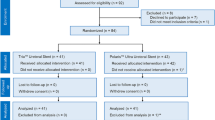Abstract
This study aims to evaluate whether optical coherence tomography (OCT) using both the surface and the endoluminal technique is feasible to investigate the locations and degree of encrustation process in clinically used ureteral stents. After removal from patients, 14 polyurethane JJ stents were investigated. A fresh JJ served as a control. The external surfaces were examined using an endoscopic surface OCT whereas the intraluminal surfaces were investigated by an endoluminal radial OCT device. The focus was on detection of encrustation or crystalline sedimentation. In 12 female and two male patients, the median indwelling time of the ureteral catheter was 100 days (range, 19–217). Using the endoluminal OCT, the size and grade of intraluminal encrustation could be expressed as a percentage relating to the open lumen of the reference stent. The maximum encrustation observed resulted in a remaining unrestricted lumen of 15–35 % compared to the reference. The luminal reduction caused by encrustation was significantly higher at the proximal end of the ureteral stent as compared to its distal part. The extraluminal OCT investigations facilitated the characterization of extraluminal encrustation. OCT techniques were feasible and facilitated the detection of encrustation of double pigtail catheters on both the extra and intra luminal surface. Quantitative expression of the degree of intraluminal encrustation could be achieved, with the most dense and thickened occurrence of intraluminal incrustation in the upper curl of the JJ stent.




Similar content being viewed by others
References
Auge BK, Preminger GM (2002) Ureteral stents and their use in endourology. Curr Opin Urol 12:217–222
Laube N, Kleinen L, Bode U, Fisang C, Meissner A, Bradenahl J, Syring I, Busch H, Pinkowski W, Muller SC (2007) Coating with plasma-deposited functionalized diamond-like carbon to decrease encrustations on urological implants. Urologe A 46:1249–1251
Stickler DJ (2008) Bacterial biofilms in patients with indwelling urinary catheters. Nat Clin Pract Urol 5:598–608
Trautner BW, Darouiche RO (2004) Role of biofilm in catheter-associated urinary tract infection. Am J Infect Control 32:177–183
Broomfield RJ, Morgan SD, Khan A, Stickler DJ (2009) Crystalline bacterial biofilm formation on urinary catheters by urease-producing urinary tract pathogens: a simple method of control. J Med Microbiol 58:1367–1375
Chew BH, Duvdevani M, Denstedt JD (2006) New developments in ureteral stent design, materials and coatings. Expert Rev Med Devices 3:395–403
Singh I, Gupta NP, Hemal AK, Aron M, Seth A, Dogra PN (2001) Severely encrusted polyurethane ureteral stents: management and analysis of potential risk factors. Urology 58:526–531
Rana AM, Sabooh A (2007) Management strategies and results for severely encrusted retained ureteral stents. J Endourol 21:628–632
Mohan-Pillai K, Keeley FX Jr, Moussa SA, Smith G, Tolley DA (1999) Endourological management of severely encrusted ureteral stents. J Endourol 13:377–379
Haleblian G, Kijvikai K, de la Rosette J, Preminger G (2008) Ureteral stenting and urinary stone management: a systematic review. J Urol 179:424–430
Zagaynova EV, Streltsova OS, Gladkova ND, Snopova LB, Gelikonov GV, Feldchtein FI, Morozov AN (2002) In vivo optical coherence tomography feasibility for bladder disease. J Urol 167:1492–1496
Daniltchenko D, Konig F, Lankenau E, Sachs M, Kristiansen G, Huettmann G, Schnorr D (2006) Utilizing optical coherence tomography (OCT) for visualization of urothelial diseases of the urinary bladder. Radiologe 46:584–589
Karl A, Stepp H, Willmann E, Tilki D, Zaak D, Knuchel R, Stief C (2008) Optical coherence tomography (OCT): ready for the diagnosis of a nephrogenic adenoma of the urinary bladder? J Endourol 22:2429–2432
Mueller-Lisse UL, Meissner OA, Babaryka G, Bauer M, Eibel R, Stief CG, Reiser MF, Mueller-Lisse UG (2006) Catheter-based intraluminal optical coherence tomography (OCT) of the ureter: ex vivo correlation with histology in porcine specimens. Eur Radiol 16:2259–2264
Mueller-Lisse UL, Meissner OA, Bauer M, Weber C, Babaryka G, Stief CG, Reiser MF, Mueller-Lisse UG (2009) Catheter-based intraluminal optical coherence tomography versus endoluminal ultrasonography of porcine ureter ex vivo. Urology 73:1388–1391
Aron M, Kaouk JH, Hegarty NJ, Colombo JR Jr, Haber GP, Chung BI, Zhou M, Gill IS (2007) Second prize: preliminary experience with the NIRIS optical coherence tomography system during laparoscopic and robotic prostatectomy. J Endourol 21:814–818
Author information
Authors and Affiliations
Corresponding author
Additional information
Markus J. Bader and Katja Zilinberg contributed equally to this paper.
Rights and permissions
About this article
Cite this article
Bader, M.J., Zilinberg, K., Weidlich, P. et al. Encrustation of urologic double pigtail catheters—an ex vivo optical coherence tomography (OCT) study. Lasers Med Sci 28, 919–924 (2013). https://doi.org/10.1007/s10103-012-1177-1
Received:
Accepted:
Published:
Issue Date:
DOI: https://doi.org/10.1007/s10103-012-1177-1




